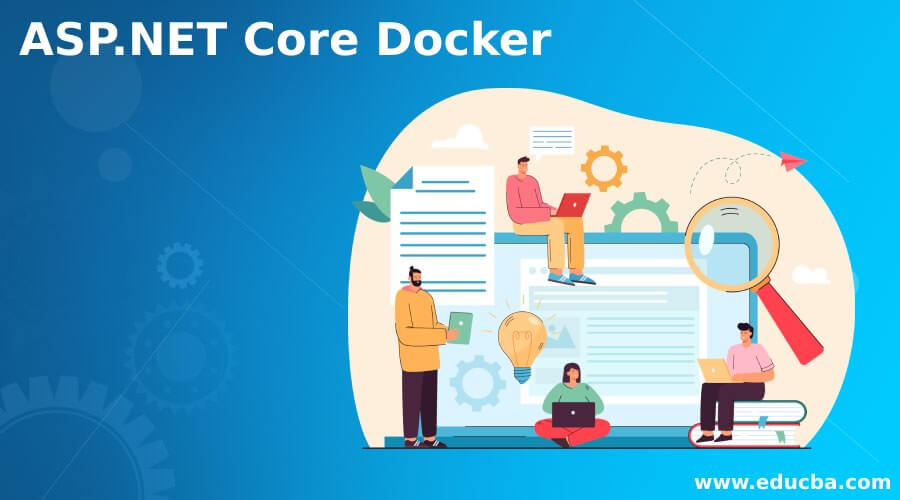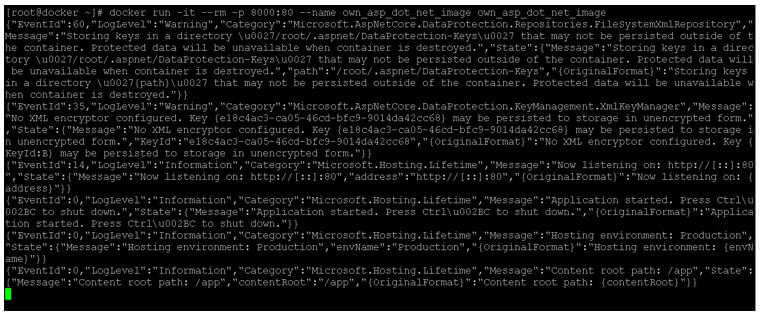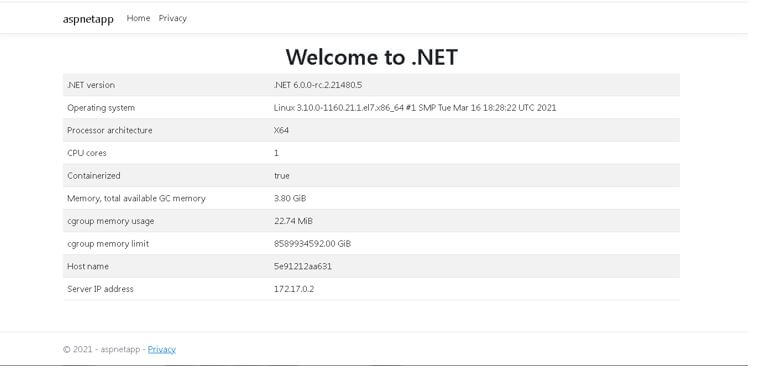Updated March 15, 2023
Introduction to ASP.NET Core Docker
In web technologies, we are having different technologies that will support the web content and deliver the task on the web. There are different technologies that are supporting it, like ASP.NET, react, JavaScript, etc. As per the requirement or the application need, we need to consider which web technology is suitable for the project, and accordingly, we need to choose it. For example, the ASP.NET is a Microsoft proprietor product. If we need to use the product for commercial purposes, then we need to get the ASP.NET product license. But suppose we will deploy or configure the ASP.NET environment. In that case, we need to take care of the complete environment responsibility, i.e., to manage the entire environment, high availability of the ASP.NET environment, data redundancy, etc.
To avoid such things or to handle the ASP.NET environment seamlessly, we need to deploy the docker environment on the docker. It will really help to manage the entire ASP.NET environment. It will handle the ASP.NET environment very easily. It will create use of the hardware resources to manage the ASP.NET environment but with reference to Linux process id. The ASP.NET docker environment is independent with reference to the existing hardware, library, configuration, etc. The docker environment will work individualistically as compared to the current hardware environment.
How to Create ASP.NET Core Docker?
The creating of the ASP.NET docker image is very easy. There are different ways to create it. As per the requirement or the project compatibility level, we need to identify how to build the docker image. There are different ways to build the docker image. First, we can consider the docker hub; here, we are getting the different ASP.NET docker images. As per the compatibility, we can choose the predefined images that are available on the Docker hub repository. In a second way, we can build our own images. As per the requirement, we need to define which version we need to select, different types of packages, libraries, etc. As per the necessary packages, we need to add to the docker base image. Once the necessary packages are updated, then we need to commit the docker images.
Before creating the docker image, we need to understand the basic docker command.
[ DOCKER ] [ PULL ] [ INTERNAL OR EXTERNAL DOCKER IMAGE LOCATION ]Or
We need to build the ASP.NET docker image with the help of the base image:
- DOCKER: We can use the docker keyword in the syntax or command. It will accept different arguments like pull, commit, image location, etc. As per the provided input, the docker will be able to pull or get the docker image from the internal or the external location and keep the pull docker image available on the current or the working environment. Here, there is no need to run the bash or shell job. We can directly run the docker command. It will run the specific process on the Linux environment. The same process ID will help to run or provide the basic docker environment.
- PULL: In the docker environment, we can use the relevant or specific keywords, i.e., pull. It will help to adopt the docker image from the external or internal docker environment.
- INTERNAL OR EXTERNAL DOCKER IMAGE LOCATION: We need to provide the docker image path from where we need to pull the docker images from the internal or the external environment.
Step by Step ASP.NET Core Docker
We are having different options to build the ASP.NET docker image. As per the requirement, we need to choose which type of docker image we need to build it. We are having the predefine docker images available on the Docker hub. So we can directly get it and work on it. If we need to build our own ASP.NET docker images, then we can also build them. But before building it, we need to take care of the prerequisite of it.
Please find below the prerequisite information of ASP.NET.
1. Operating System Support
Windows 7 SP1 or later, Windows 8.1, Windows 10 Ver 1607 or later, Windows Server 2012 SP1 (with Full Server / Server Core), Windows Server 2008 R2 SP1 (with Full Server / Server Core), Windows Server 2012 SP1 (with Full Server / Server Core), Red Hat Enterprise Linux or CentOS 7, Ubuntu 14.04, 16.04, 17, Windows Server 2012 R2 (with Full Server / Server Core, Windows Server 2016 (with nano server / Full Server / Server Core), Mac operating system like X 10.11, 10.12*.
2. Development Environment Support
- Microsoft Visual Studio 2015 Update 3 (minimum) , 2017 version latest (15.6.4), 2019, 2022
- .NET Framework: Minimum .NET 4.5.1 upto .NET 4.7
- Command Line (optional. necessary for command line deployment)
- Visual Studio Code (optional text-editor)
- SQL Server 2008 Express (optional)
- .NET Core 3.1
3. Browser Support
- Chrome with the latest version
- Firefox with the latest version
- Opera with the latest version
- Edge with the 13+ version
- IE with the 11+ version
- Safari with the 9+ version
- iOS with the 9+ version
- Android with the 4.4+ version
- Windows Mobile with the IE 11+ version
We need to install the relevant packages and create the ASP.NET docker image as per the above information.
Example of ASP.NET Core Docker
Different examples are mentioned below:
Run the ASP.NET image on docker.
In the docker environment, we are able to run the ASP.NET docker image.
Code:
docker run -it --rm -p 8000:80 --name own_asp_dot_net_image own_asp_dot_net_imageExplanation:
- As per the above command, we are running the ASP.NET image on the Docker platform.
Output:
Applications of ASP.NET Core Docker
Given below are the applications mentioned:
- As per the application or project need, we need to choose the core component of ASP.NET.
- Running the ASP.NET image, we need to ensure that the components are available in the docker image.
Conclusion
We have seen the uncut concept of the “ASP.NET Core Docker” with the proper example, explanation, and command with different outputs. Running the ASP.NET environment on the docker is very convenient to use. It will be very easy if we need to migrate or upgrade the ASP.NET environment.
Recommended Articles
We hope that this EDUCBA information on “ASP.NET Core Docker” was beneficial to you. You can view EDUCBA’s recommended articles for more information.





